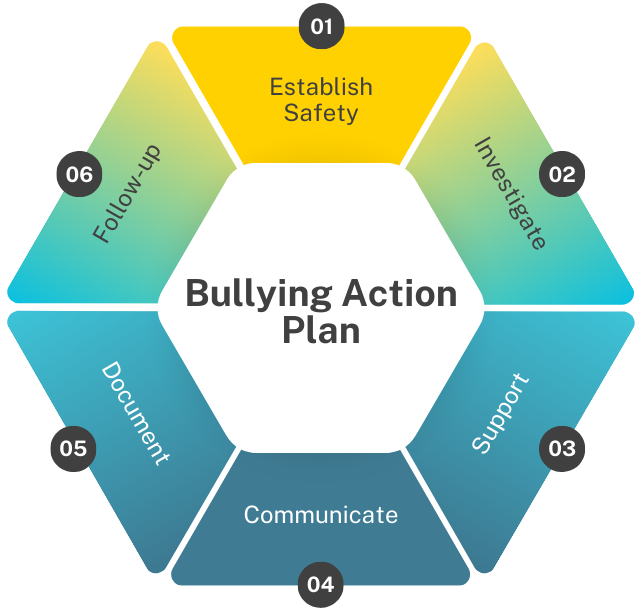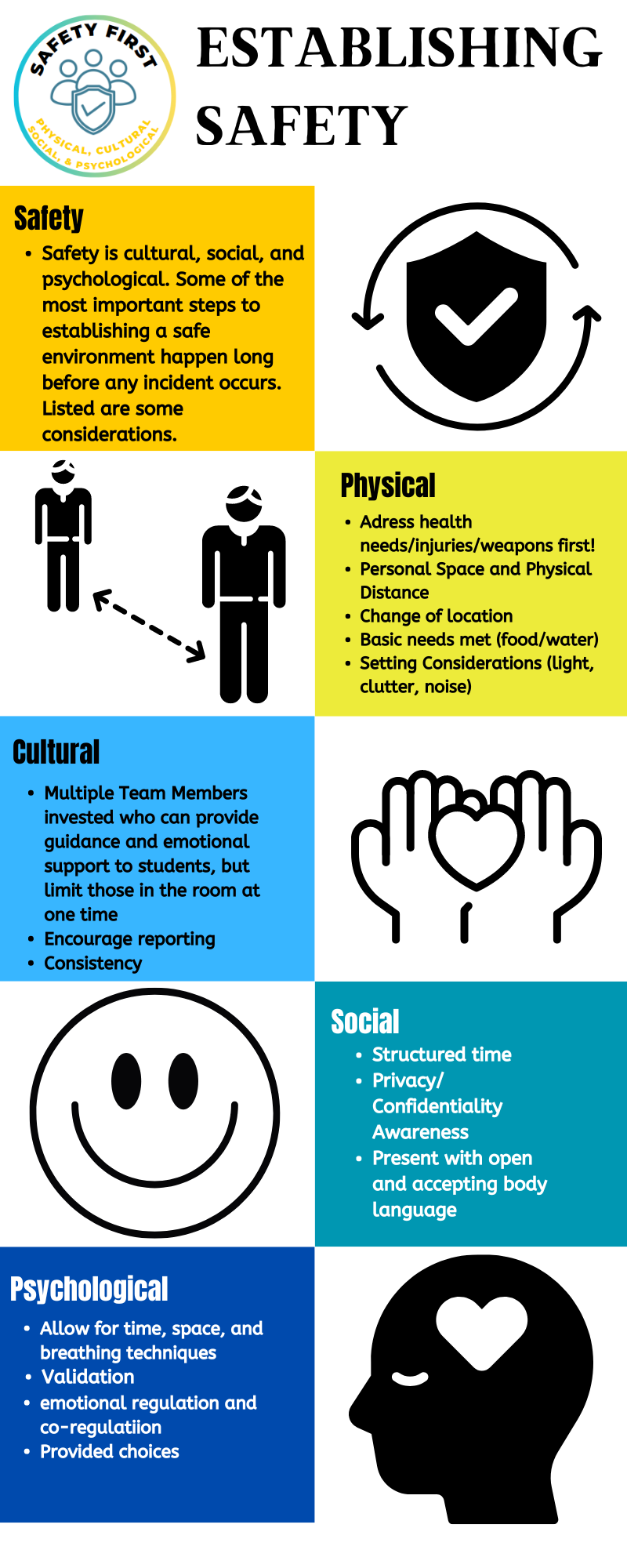General Reminders Regarding Bullying Support Best Practices
 Bystander intervention training is essential; training a school’s staff and students on recognizing, reporting, and responding to incidents of bullying reduces this behavior.
Bystander intervention training is essential; training a school’s staff and students on recognizing, reporting, and responding to incidents of bullying reduces this behavior.- A culture of compassion is created by ALL, especially the adults. Modeling compassion is the most effective way to teach it, and situations that involve bullying behavior are high-stakes opportunities to build a culture of compassion.
- Zero tolerance and exclusion do not work.
- A caring response to reports (even with less serious incidents) supports honesty and intervention with future incidents.
- A conversation and a connection is always better than a correction or consequence.
- Proactive planning is essential to prevention and response, follow through on evidence-based prevention strategies as outlined in your school’s prevention plan.
- Multi-disciplinary teaming is necessary to meet student’s needs, involve a variety of professionals in prevention and intervention planning.
- An action plan for incidents of bullying is required by law, including documentation and implementation tracking.
- Mediations, restorative practices, apologies, or problem solving discussions with both students present are not recommended for scenarios with an imbalance of power.
Creating a Culture of Compassion: Bullying Action Plans Training Slides
Establish safety
- Keep in mind that this step is never “done” and you may need to work to protect a student or staff member from harm before you have all the information.
- How we act and interact throughout incidents is teaching and creating the culture. Adult behavior is always modeling to students.
- Safety is cultural, social, and psychological. Some of the most important steps to establishing a safe environment happen long before any incident occurs. Here are some guiding questions to support a safe environment.
- Do individuals receive support when reporting safety concerns?
- Are there ways for individuals to anonymously report concerns?
- Do individuals trust that interventions will improve safety or will people just "get in trouble."
- Are strategies for recognizing, reporting, and responding to bullying explicitly taught and modeled?
- Are bystander intervention strategies explicitly taught and modeled? (i.e. Stop, Walk, Talk)
- Are conflict resolution skills explicitly taught and modeled?
- Are emotion regulation skills explicitly taught and modeled?
- Offering time, space, or resources (i.e. water/food) for de-escalation can enhance safety.
- Physical distance can help reduce tension.
- Safety plans ought to include unstructured time like recess, passing times, time in the office while investigating, etc.
- Adult supervision, when possible, can be helpful to ensure safety.
- Collaborate with students, parents, and other staff members (including SRO’s and teachers) when establishing safety. No person can create a safe environment alone!

Incidents of bullying, cyber-bullying, hazing, or abusive conduct can disrupt a student's sense of safety even when the incident doesn't seem severe.
Consider conducting a suicide risk screening or a threat assessment (C-STAG) as part of the investigation and establishing safety.
School discipline (i.e. suspension) and involvement in incidents of bullying are KNOWN risk factors for suicide, keep that in mind throughout the action planning process
Investigate
Check your own emotions and give yourself time to de-escalate before gathering information. Decisions are not made on assumptions.
- Offer time for students to regulate their emotions before asking them to provide information.
- Collect written statements and reports when possible.
- Be curious not judgmental, listen without blaming.
- Keep all the involved children separate and avoid a group setting.
- Get the story from several sources, both adults and kids.
- Don’t call the act “bullying” while you are trying to understand what happened. Also, don’t correct students who call it “bullying” even if you don’t think that it meets the definition.
- Use open ended questions, “tell me what happened today."
- Listen and validate emotions, offer gratitude as students tell their story, ”thank you for sharing this with me.”
- Ask directly about intent to harm (others or self).
- Check for supporting information (talk to teachers and mental health team, review grades and discipline history).
- Key Investigation components to remember: where it occurred, who knows about the incident(s), what actions have already been taken by school staff; if the bullying was physical gather photographs to document injuries or damage to clothing and gather screenshots of online incidents.
Support
- Students are best supported by a variety of adults who work in a variety of roles. Each person in a student's life is an essential part of their sense of safety and support.
- Keep critical needs in mind and add supports when any of the following are evident:
- Individual endorses thoughts of self-harm or harming others (C-STAG).
- Individual exhibits new, disruptive, or unhealthy behaviors (i.e. excessive absences).
- Individual is part of a vulnerable group or population, including having a disability.
- Other data or prior incidents indicate additional needs
- Use the screening tool below to quickly and more deeply understand what aspects of a students life may require additional support or intervention:
Reported Victim/Target/Bystander Support Screening
Almost Never - 4 Sometimes- 3 Often-2 Almost Always - 1
_____ Reported target feels safe at school, including during unstructured time (e.g. passing time)
_____ Reported target has positive interactions with peers
_____ Reported target has positive interactions with adult staff
_____ Reported target attends school and actively participates in learning
_____ Reported target asks for help when incidents occur
_____ Reported target demonstrates the ability to resolve conflicts
_____ Total Support Score: a higher score means that this student is at higher risk.
Reported Aggressor Support Screening
Almost Never - 4 Sometimes - 3 Often - 2 Almost Always - 1
_____ Reported aggressor is apologetic and willing to work toward a resolution
_____ Reported aggressor demonstrates empathy towards others involved
_____ Reported aggressor has positive interactions with peers
_____ Reported aggressor has positive interactions with adult staff
_____ Reported aggressor attends school and actively participates in learning
_____ Reported aggressor demonstrates the ability to resolve conflicts
_____ Total Support Score: a higher score means that this student is at higher risk.
Other essential support reminders
- Using mediation to address bullying may send the wrong message to students--for example, “you are both partly right and partly wrong,” or “we need to work out this conflict between you.” The message to a child who is bullied should be, “no one deserves to be bullied, and we will do everything we can to stop it.” The message for children who bully should be, “your behavior is inappropriate and you must stop it.”
- Mediation may be very upsetting to a child who has been bullied. Facing the child who was the bully may make the child who was bullied feel worse.
- There is no evidence that conflict resolution or peer mediation stops bullying.
- There is evidence that a culture of belonging prevents incidents of bullying, which may be supported by conflict resolution and mediation outside of bullying incidents.
Examples of Support
Include Individual Support for BOTH Victims and Aggressors
Use PBISWORLD.COM to identify specific interventions!
Less Serious or Transient
Supporting students by allowing them to work through less serious situations builds their skills and prevents further issues.
- Social skills reinforcement
- Teach or re-teach emotion regulation, problem solving, anger management, self-regulation, conflict resolution, or other skill
- Wellness Center Visit
- Mental Health Staff check-in
- Apology letters
Serious Substantive
- Student Wellness Plan
- Safety Plan
- Mental Health Staff check-in
- Mental Health recommendation: JFEC, MHAP, etc.
- Mediation
- Restorative Conferences
- Parent conference
- Teach or re-teach social or emotional skills relevant to the situation
- Behavior Intervention Plan
- No-Contact Agreement or Contract
- In school suspension with life skills reinforcement
- Out of school suspension with re-integration plan
Very Serious Substantive
As a reminder, mediation or apologies with both students present are not helpful in situations of bullying with a clear power differential or abusive conduct
- Student Wellness Plan Meeting
- Mental health staff Check-In
- Parent conference
- Daily check-in/check-out
- Safety plan
- Functional Behavior Assessment (FBA)
- Behavior Intervention Plan (BIP)
- In school suspension with life skills reinforcement
- Safe Schools Hearing
- Mental health referral or recommendation
Communicate
- Use this link for email templates
- Even when meeting in person or on the phone, send a follow up email highlighting key points to student’s parents. Pro-tip: When you send your first email, do a “scheduled-send” check-in so that you are proactively following up.
- Maintain student privacy and only relay information relevant to their own student.
- Communicate supportive measures and concern for all students involved.
- Maintain warmth and rapport and explain your limits on what you can and can’t share.
- Be factual “when I asked them what happened, they said …” “several reports from students and/or adults claimed that …”
- Validate emotions and don’t take parent reactions personally. You can do a good job and have people unhappy with what happened.
- It can be helpful to include some resources for student's family. Here are a few ideas that could be helpful.
This episode of the Supercast may also be shared as a resource to parents!
Episode 159: How to Identify Bullying Behavior and Stand Up to Stop a Bully
Document
- Log both offender and victim with actions taken in Skyward.
- Complete Parent Contact Form in Skyward.
- Remember that email IS documentation.
- Team meeting notes regarding intervention can also serve as documentation.
- When logging in skyward, ONLY REPORT INCIDENTS OF BULLYING THAT ARE ACTUALLY BULLYING. This is a State reported category and should not include all situations related to bullying.
- Be mindful of whether the conduct included anything that may trigger a school’s obligations under civil rights laws (e.g., sexual harassment; harassment based on sex stereotypes, race, or national origin; disability) and any impact the conduct may have had on the student who was bullied that could interfere with access to education based on race, sex, disability, or other factors.
- Documentation should be FACTUAL, not an opinion.
- Factual: "Student said _________ to _________."
- Opinion: "Student was mean to ____________."
- Factual: "Evidence doesn't support ____________'s statement."
- Opinion: "_____________ lied in their statement."

Follow-up
- Bullying may not end overnight. Commit to making it stop and consistently support the bullied child. Continued communication with students and parents involved.
- Involve other staff members in follow-up and check-in efforts.
- Pro-tip: When you send your first email, do a “scheduled-send” check-in so that you are proactively following up.
- Use your team meetings as a way to collaborate and support the students involved (i.e. MTSS team meetings) and ensure regular follow-up with high risk students. Continue to document interactions and supports as appropriate.
- Designating a point person for follow-up and check-in can ensure that it doesn't get missed!

